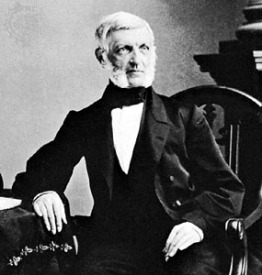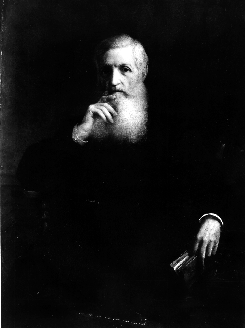American Historian: George Bancroft
I’m back from Christmas break and trying to recuperate from a few too many cinnamon rolls. Reading assignments and preparation of a research proposal due Sunday are top of mind.
The class is Historiography so the research isn’t to be about the development and proof of a thesis. It’s more about research into the history of how history was written.
 For my research paper, I plan to explore the influence of historian George Bancroft (right) on Antebellum, Civil War, and Postbellum American history. I may need to shave this down a bit depending on how much material I find.
For my research paper, I plan to explore the influence of historian George Bancroft (right) on Antebellum, Civil War, and Postbellum American history. I may need to shave this down a bit depending on how much material I find.
Bancroft was one of the best known American historians of the 19thcentury. While Harvard educated (he entered at 13 and graduated at 17!), he is considered a “literary historian,” who wrote in a style popular with  the public. His primary work was the multi-volume History of the United States from the Discovery of the American Continent, which he began writing in 1830. [Picture left of remaining vHe published the first three volumes over that decade. The final set would be ten volumes. A first revision was completed and published as six volumes in 1876 as part of the national centennial.
the public. His primary work was the multi-volume History of the United States from the Discovery of the American Continent, which he began writing in 1830. [Picture left of remaining vHe published the first three volumes over that decade. The final set would be ten volumes. A first revision was completed and published as six volumes in 1876 as part of the national centennial.
Perhaps less known is that Bancroft, while Secretary of the Navy, created the Naval Academy. He was also chosen by Congress to eulogize Abraham Lincoln. The New York Times reprinted that Eulogy on the occasion of the fiftieth anniversary of the event in 1915. It, along with drawings of the event, can be seen in their entirety here.
I have located the index to his papers housed on microfiche at Cornell University and two biographies which leverage that material. The first, a two volume set 1971 reprint of M.A. DeWolfe Howe’s 1908 work The Life and Letters of George Bancroft, I was able to find on the Amazon Marketplace in almost pristine shape. The second, George Bancroft: Brahmin Rebel, was written by Russel B. Nye and published in 1945. It’s on order. There are other large collections of Bancroft materials in holdings by the Massachusetts Historical Society, the Library of Congress and the New York Public Library. I’m beginning in earnest a search for articles that deal with his contributions to American history as well.
As a follow-up at some later point, I think it would be very interesting to contrast the style and impact  of George Bancroft with Charles and Mary Beard. As a historian friend of mine said, “you’d be hard pressed to find two more different expositors on the American experience than Bancroft and Beard. Bancroft was an unabashed patriot and advocate of democracy, to a degree that would be considered embarrassing in most academic settings today. Still, he was indeed the most articulate and widely-read of our early historians, and his writings both reflected and helped to create the sense of American exceptionalism that has prevailed for most of our history as a nation.”
of George Bancroft with Charles and Mary Beard. As a historian friend of mine said, “you’d be hard pressed to find two more different expositors on the American experience than Bancroft and Beard. Bancroft was an unabashed patriot and advocate of democracy, to a degree that would be considered embarrassing in most academic settings today. Still, he was indeed the most articulate and widely-read of our early historians, and his writings both reflected and helped to create the sense of American exceptionalism that has prevailed for most of our history as a nation.”
You might recall that Charles and Mary Beard were the first to suggest that the Civil War was the second American revolution as was mentioned in my previous post here.
The exceptional oil on canvas portrait above of Bancroft in later life was painted by Gustav Richter, a German painter (1823 – 1884). It is a part of the Harvard University Portrait Collection and is on display at Memorial Hall.
More as I get into my research.
Photo credits:
Photo of George Bancroft in middle age taken by Mathew Brady, courtesy of the Library of Congress.
Photo of painting above: The President and Fellows of Harvard College.















































Leave a comment